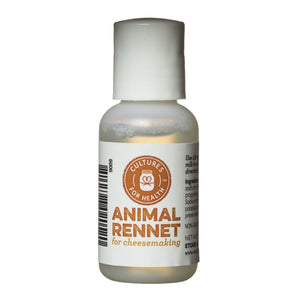
Stirred-curd cheddar, similar to farmhouse cheddar, could also be called “shortcut cheddar,” for it is a faster and easier way to make this popular cheese. Traditional cheddars take longer and require more attention to detail, while this type of cheddar is good for both beginning cheesemakers and those with less time to devote to cheesemaking.
10 minutes
45 minutes
10 Servings
INGREDIENTS AND EQUIPMENT AVAILABLE AT CULTURES FOR HEALTH
Mesophilic Direct-Set Starter Culture

Mesophilic Direct-Set Starter Culture
$19.99
From cheddar, Colby, and Monterey Jack to Feta, Chevre, and more, you'll enjoy the flavor and variety of homemade cheeses made using this starter culture.
Liquid Animal Rennet

Liquid Animal Rennet
$12.99
High quality single strength animal rennet. This non-GMO animal rennet is preferred for aged cheese as it creates a more desirable flavor and aroma during the aging process. Each bottle contains enough rennet to set (12) 2-gallon batches of cheese.
Cheese Salt

Annatto Cheese Coloring
INGREDIENTS:
- 2 gallons whole milk
- 1 packet direct-set mesophilic culture
- 1/2 tsp. liquid rennet diluted in 1/4 cup water
- 2 Tbsp. cheese salt
- You can also color this cheese, if you wish. If you are going to do this, you can have 4 drops of cheese coloring diluted in 1/4 cup water ready to go.
INSTRUCTIONS:
- Heat the milk to 90°F. Add the starter and mix it in using an up-and-down motion for 1 minute. Cover milk and leave it to ripen for 45 minutes.
- Mix in the coloring, if you are using it, and stir it in using an up-and-down motion.
- Check to make sure the milk is still 90°F. If it isn’t, bring the temperature back up. Add the rennet and stir in using the same up-and-down gentle motions for 1 minute. If you are using farm-fresh cow milk, top-stir for 2 more minutes. Cover your milk and allow it to set at 90°F for 45 more minutes, making sure you keep a steady 90°F temperature.
- Once you have a clean break, cut the curd into 1/4-inch cubes.
- Allow the curds to set for 15 minutes, then heat them to 100°F, bringing the temperature up by a maximum of 2°F every 5 minutes. Stir frequently to keep the curds from sticking together (matting). Once the curds reach 100°F, maintain the temperature for 30 more minutes, and keep stirring periodically but not continually. After the last 30 minutes is up, cover the curds and whey and let them rest for 5 minutes.
- Drain off the whey and pour the curds into a colander suspended over a large bowl. Drain them for several minutes, then pour the curds back into the pot and stir them with your fingers. Don’t allow your curds to drain in the colander for too long, or they will begin to mat. If some have matted by the time you have dumped them back into the pot, very gently break them up with your fingers.
- Add the salt to the curds in the pot and mix it in well. Try not to squeeze the curds.
- Keep the curds in the pot at 100°F for 1 hour, stirring them with your fingers every now and again to keep them from matting. (You can fill a sink or a large bowl with water and set your pot into it, and keep the surrounding water at 100°F by taking out some water when the temperature begins to drop and adding heated water until it reaches the proper temperature again.)
- Scoop the curds into a 2-pound cheese press lined with cheesecloth. Press at 15 pounds of pressure for 2 minutes.
- Remove the cheese from the press, peel off the cheesecloth, flip the cheese, re-dress it, and put it back into the press at 30 pounds of pressure for 10 minutes.
- Remove, undress, flip, and re-dress the cheese. Place it back into the press at 40 pounds of pressure for 2 hours.
- Remove, undress, flip, and re-dress the cheese. Place it back into the press at 50 pounds of pressure for 24 hours.
- Remove the finished cheese from the press. Peel away the cheesecloth and dry the cheese on a drying mat at room temperature away from drafts for 3 to 5 days or until the rind is dry to the touch. Flip it about 5 times a day during the drying process. After it has dried, wax it and age it at 45° to 50°F for 2 to 5 months.
















